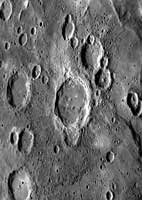|
COMETS EARTH JUPITER KUIPER BELT MARS MERCURY METEORITES NEPTUNE OORT CLOUD PLUTO SATURN SOLAR SYSTEM SPACE SUN URANUS VENUS ORDER PRINTS
PHOTO CATEGORIES SCIENCEVIEWS AMERICAN INDIAN AMPHIBIANS BIRDS BUGS FINE ART FOSSILS THE ISLANDS HISTORICAL PHOTOS MAMMALS OTHER PARKS PLANTS RELIGIOUS REPTILES SCIENCEVIEWS PRINTS
|
Related Documents
Download Options
Date Acquired: September 29, 2009 This newly observed flat-floored crater was viewed at an oblique angle as MESSENGER approached Mercury for its third flyby, about two hours from closest approach. This crater is younger than nearby craters of similar size, indicated by the distinctive halo of small secondary craters that radiate outward from the central structure. Many of these secondaries are aligned in chain-like formations and some show characteristic "herringbone" features pointing back to the crater of origin. Crater chains are just one of many ejecta types observed on Mercury. Other ejecta features include distinct continuous ejecta and crater rays, which are composed of both ejecta and secondaries. Another ejecta feature of note in this mosaic of two images is a zone of lighter terrain extending a bit west of north from the crater itself, possibly providing information about the direction of impact. This unnamed crater is partially superposed on an older and smaller crater to the south. Credit: NASA/Johns Hopkins University Applied Physics Laboratory/Carnegie Institution of Washington |
